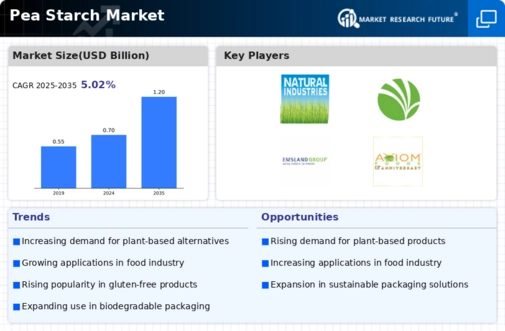Market Analysis
In-depth Analysis of Pea Starch Market Industry Landscape
The market dynamics of the pea starch industry are influenced by a variety of factors, creating a dynamic and evolving landscape for market participants. Pea starch, a versatile ingredient derived from peas, has gained prominence due to its functional properties and the increasing demand for plant-based alternatives. Consumer preferences play a pivotal role in shaping the pea starch market. As more consumers seek plant-based and clean-label products, the demand for pea starch has witnessed a significant uptick. Its application in various industries, including food and beverage, pharmaceuticals, and textiles, has expanded, driven by the growing awareness of its nutritional benefits and sustainable sourcing. Economic factors contribute to the market dynamics of pea starch as well. Fluctuations in agricultural conditions, such as weather patterns affecting pea crops, can impact the overall supply and pricing of pea starch. Additionally, the cost of production, influenced by factors like energy prices and labor costs, plays a role in shaping market dynamics. As the global economy evolves, shifts in consumer purchasing power and spending patterns can influence the demand for pea starch-based products. Technological advancements also play a crucial role in shaping the pea starch market. Ongoing research and development efforts focus on improving extraction methods, enhancing the functional properties of pea starch, and expanding its applications. Innovations in processing technologies contribute to the production of high-quality pea starch that meets the diverse needs of food manufacturers and other industries. This constant innovation fosters competitiveness and drives market growth. The competitive dynamics within the pea starch market are characterized by the presence of key players and the emergence of new entrants. Large multinational companies often dominate the market, leveraging their resources for extensive research, marketing, and distribution networks. However, the industry also sees the participation of smaller, specialized players offering niche pea starch products tailored to specific applications or consumer preferences. This mix of market participants contributes to healthy competition, encouraging innovation and diversity in product offerings. Regulatory factors significantly impact the pea starch market, especially as consumers and regulatory bodies prioritize sustainability and clean-label products. Stringent regulations related to food safety, labeling, and environmental sustainability shape the practices of pea starch manufacturers. Compliance with these regulations is crucial for market access and consumer trust. Additionally, as consumers increasingly seek transparency in ingredient sourcing and processing, adherence to quality and sustainability standards becomes a key factor in market dynamics. Globalization has further intensified the pea starch market dynamics, with supply chains extending across borders. Changes in trade policies, geopolitical events, and transportation costs can influence the availability and pricing of pea starch globally. The interconnectedness of the global marketplace requires industry participants to stay vigilant and adaptable to navigate challenges and seize opportunities.

















Leave a Comment